“Closely Akin to Actual Warfare”
Published in 18th–19th - Century History, Features, Issue 4 (Winter 1999), Volume 7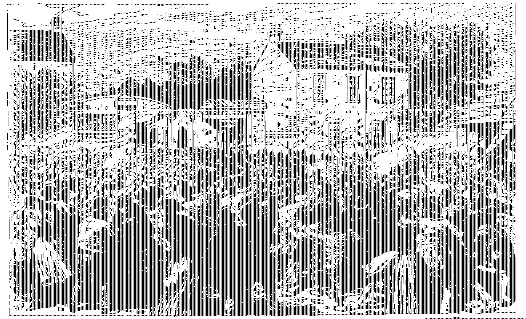
Mob-wrecking the tramway company’s depot at milltown – (Illustrated London News, 21 August 1886)
The journalist Frankfort Moore, writing in 1914 about events he witnessed in the late nineteenth century, described the Belfast riots of 1886 as being ‘closely akin to actual warfare’. Notwithstanding his touch of hyperbole, the riots were costly in human and financial terms: thirty-two people died, hundreds of people were injured and some £90,000 worth of damage was caused. Belfast had endured frequent eruptions of public disorder during the first half of the nineteenth century. However, these were ‘side-shows’ compared to the second half of the century when more serious riots occurred in 1857, 1864, 1872, 1880, 1884, 1886 and 1898. Frankfort Moore identified ‘seismic areas’ of Belfast where these riots occurred most frequently but, far from being of civil-war proportions, these conflicts were usually very localised, indeed the 1886 riots were almost all in West Belfast, taking place in the Brickfields and Springfield, a ‘no-man’s land’ between the two religious communities.
‘A Popish force’?
Prior to 1 September 1865 Belfast Town Council had maintained its own small borough police force. Rightly or wrongly, this force was perceived as inefficient and sectarian. The commission appointed to investigate the riots of 1864 recommended the abolition of this force and under the provisions of the Constabulary (Ireland) Amendment Act, 1865, the Royal (after 1867) Irish Constabulary (RIC) assumed control of the town. This deprivation of local control upset the Town Council and other members of the Protestant community: the Belfast News Letter referred to the ‘green badge of disgrace’ and prisoners in custody cursed the Belfast RIC for being, ‘a Popish force, a bloody lot of Fenians [and] Popish brats’ in the mistaken belief, perhaps, that the Belfast force consisted solely of Catholic policemen. It was, in fact, an erroneous belief because the RIC was concerned from the outset to have slightly more Protestant policemen than Roman Catholics in order to reflect the composition of the general population of Belfast.
This public perception of an imposed national force served to make the RIC seem remote from the majority Protestant population and, whilst middle-class citizens gradually became more tolerant of the RIC, the working-class population did not, and when riots occurred in 1880 the Freeman’s Journal spoke of an ‘old enmity’ between the Protestant combatants and the RIC. This antipathy was not exclusive to Protestants because the Catholic working-class population displayed somewhat the same animus towards the RIC and the Belfast Newsletter was similarly replete with insults used by Catholics. However, the sectarian epithets used by both denominations would tend to suggest that working-class residents of Belfast chiefly regarded the RIC as an alien force, planted amongst them to regulate their behaviour and customs. The sectarian insult was simply the worst abuse they could muster. This hostile perception of being policed by strangers was compounded by the sheer number of these policemen. Belfast’s police force almost trebled from the 200 borough policemen in 1864, so that by 1886 Belfast had one RIC man per 337 inhabitants, thus making it one of the most intensively policed cities in the United Kingdom.
The casus belli for the terrible riots of 1886 was a relatively minor quarrel which took place on 3 June at the Alexandra Dock between a Protestant worker called Blakely and a Catholic father and son called Murphy. One of the Murphys struck Blakely saying ‘that neither he [Blakely] nor any of his sort should get leave to work there, or earn a loaf there or any other place’. An innocuous incident perhaps, but set against the background of the presentation of the contentious Home Rule Bill to parliament and all the political tension this had engendered throughout Ireland, and especially in Belfast, it was a sufficient spark to kindle the flames of sectarian animosity. On 4 June a large group of Protestant riveters from the Queen’s Island works attacked the mainly Catholic navvies at the Alexandra Dock. One Catholic boy drowned whilst trying to flee via the River Lagan, and ten more Catholics were injured. The riots which followed developed into three distinct phases: the first lasting from 4 June until 10 June; the second from 12 July until 14 July; and the final phase from 31 July until 21 September. The intervening periods between each phase were generally quiet with just the odd occurrence of minor rioting.
Following the events of 4 June 400 police reinforcements arrived in fifty-man sections, drawn from southern Irish counties, with the majority of these being employed in riot control duties. Approximately one-sixth of each section were Belfast RIC men and about one-third of the total number were equipped with batons, the remaining constables being armed with rifles and sword bayonets.
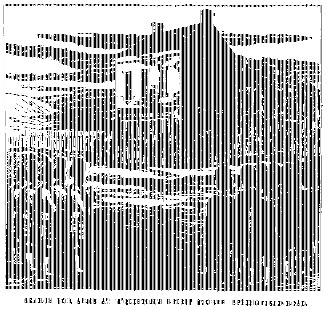
(Illustrated London News, 21 August 1886)
The equipping of the constables on detached duty with rifles was neither new nor strange. It was established practice, but two things were different in 1886 compared to previous Belfast riots: firstly, there was a higher proportion of riflemen than the regulation fifty-fifty mix of batonmen and riflemen; and secondly, rifles were used to deadly effect. Of the thirty-two deaths during the riots, about twenty-four were the result of police rifle fire—more than in any other riot in Belfast during the nineteenth century.
‘Belfast confetti’
This use of firearms was not exclusive to the RIC for there were many occasions when the 1886 rioters opened fire with revolvers and rifles, but it was the infamous Belfast ‘kidney pavers’ which most often wrought havoc among the RIC. These kidney-shaped paving stones were prised from the streets by women and children and passed to their men folk who generally threw them with accuracy, despite their average two pound weight. Further ammunition was supplied by iron rivets, screws and nuts, filched from the shipyards, and propelled in many cases by catapults. This ‘Belfast confetti’ and its heavier counterpart the ‘kidney paver’ accounted for the larger portion of the 371 injuries suffered by the RIC during the riots.
On 8 June the House of Commons threw out the Home Rule Bill. Belfast’s Protestants were overjoyed, immediately beginning to celebrate the bill’s defeat. As the celebrations continued into the night, sections of the crowd that had assembled on the Shankhill began rioting. During the latter part of the following day, District Inspector William Grene, whose Northern District command included the strategic Shankhill Road (Bowershill) Barracks, anticipating a further night of rioting, decided to brief the police allocated to his area. The withdrawal of the 210-strong force from the Shankhill to the Donegall Street Barracks for briefing effectively denuded the Shankhill Road of police and, doubtless aware of this, rioters began attacking the police barracks, which now only contained three policemen, and O’Hare’s public house opposite. A series of running skirmishes began as hurriedly recalled police reinforcements arrived from Donegall Street to protect the besieged police barracks and public house. However, the bulk of the policemen thus despatched were countrymen, and their commanders, District Inspector Mulliner and Head Constable Markham, were both strangers to Belfast. As one RIC detachment under Markham attempted to clear the street from O’Hare’s down to North Howard Street, some 1,300 foundry men from the Coombe and Barbour works, having finished work, left the foundry gates, spilling onto North Howard Street. As was their wont the workforce divided into their denominational groups and the 800-strong Protestant workers, proceeding in a compact body, ran towards the Shankhill Road.
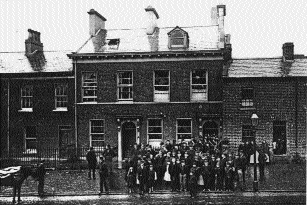
Bowershill RIC barracks on the Shankill Road the day after the ‘battle’. (Welch Collection, National Museums and Galleries of Northern Ireland)
The evidence of what transpired is somewhat contradictory but the immediate reaction of the rural policemen, perhaps believing the foundry men were a hostile crowd, was to charge and attempt to disperse them using their batons freely.
Battle of Bowershill
The police baton attack was fierce and a number of workers were badly injured. As one of the commissioners later sent to investigate the riots pointed out, ‘this occurrence…greatly increased the excitement then prevailing, and intensified the prejudice…against the county police’. Following this fracas, intermittent, but severe, running battles occurred over the next few hours. The RIC, struggling to cope, made two major forays and several minor ones, followed by orderly withdrawals to the besieged barracks. By 8.15 pm the crowd had grown to some 5,000-5,500 and the RIC, unable to master them without reinforcements, began a third withdrawal to the Bowershill barracks. During the course of this withdrawal the RIC men, having endured the violence and stone throwing with a remarkable passivity, were at the end of their tether and appealed to DI Grene to open fire. Grene refused, but as they reached the barracks, the men, desperate to escape the rioters’ stones, became jammed in the narrow doorway. The crowd redoubled their efforts and the policemen, finding their entry blocked and having, they perceived, no other choice but to defend themselves, turned and, without orders, fired. Amidst the clatter of stones and confusion, the shots appeared to those RIC men, both within and without of the barracks, to have been under orders and they too commenced firing. Once DI Grene and the others effected an entrance to the barracks, the DI and a small number of men fired from the upstairs windows to prevent those rioters, who they believed were going to sack the barracks, from forcing entry.
Eventually reinforcements were notified by runners, the severity of the rioters’ bombardment having destroyed the telegraphic equipment. However, a detachment of the Highland Light Infantry, together with a reserve of policemen, took an hour to fight their way to Bowershill, such was the ferocity of the crowds. The arrival of the military ended what became known as the ‘Battle of Bowershill’, and the besieging mobs dispersed from the Shankhill which, to The Times, ‘presented the appearance of a bombarded town’.
The RIC had killed seven people, five of whom were completely innocent, and seriously injured a further twenty-six. Not surprisingly, the actions of the RIC enraged the Protestant population and provoked a flurry of concern at Westminster. Whilst the local Protestant reaction and that of MPs like Edward Cobain were largely predictable, and, although, the Riots Commissioners later generally exculpated the RIC, it was, nevertheless, a horrendous twenty-four hours for the police and one which set the tone for almost all of the subsequent clashes between the RIC and the residents of the Shankhill during 1886.
Hostile press
Although rioting continued post-Bowershill, the passions of the crowd did not reach the ferocity of 9 June and, after the funerals of the victims, the situation quietened with the RIC beginning a phased withdrawal of its reinforcements on 14 June which was completed by 22 June. At the height of the first phase of the riots some 1,600 RIC men had been deployed in Belfast from the force’s total strength of 12,860 and, despite the support of infantry and cavalry, the RIC had not covered itself in glory. However, their reputation in general and that of the county detachments in particular could not have been helped by either the hostile press or by a decision on 10 June of the Mayor and borough magistracy ‘that the county constabulary should not be used in the disturbed districts unless it should become absolutely necessary’. The suggestion that this decision was a capitulation to the demands of a Protestant deputation from the Shankhill Road must have further embarrassed the constabulary and surely dented the men’s morale.
The policing of the next phase of the riots had its familiar aspects, with the RIC planning to cope with the party excitement caused by the 6 July general election, following the defeat of Gladstone’s Home Rule Bill, and the perennial problem of the 12 July Orange demonstrations. In the event no significant rioting attended either occasion despite a Catholic Home Rule candidate, Thomas Sexton, winning in West Belfast. The real trouble began mid-afternoon on 13 July, when a band marching to the opening ceremony of an Orange Hall at Ballynafeigh came under sustained attack from a Catholic mob. Serious rioting ensued which spread to a number of Belfast’s districts. When ‘battle’ commenced at the Brickfields that evening police attempts to separate the protagonists were met with revolver and rifle fire from Protestant rioters and, although RIC casualties from these early exchanges were light, a head constable and a private of the West Surrey Regiment were later killed.
The police response during this day of rioting was an effort to force the rioters apart and turn them back to their own areas. However, their attempts to do so were met with considerable resistance and the police were ultimately unable to cope without the aid of 400 soldiers. At the height of the conflict one police detachment, under DI McClelland of King’s County, surrounded, heavily stoned and in danger of being swamped, fired one shot to disperse the mob. When this failed they opened fire severally and two rioters subsequently died.
The final phase of the Belfast riots was, according to the RIC Inspector General, Andrew Reed, ‘the most arduous and responsible duty I ever discharged in my whole service’. The despatch of Reed to Belfast on 7 August by the new Chief Secretary, Sir Michael Hicks Beach, was partly a tacit admission that the authorities in Belfast had failed thus far and partly an indication of how serious things had become. The riots flared up on 31 July after a Sunday School excursion led by the Reverend Hugh Hanna was attacked by a Catholic mob. What followed was a now familiar scenario of internecine rioting between the two rival factions accompanied by ever more bitter conflict with the RIC—conflict which later involved increasing Catholic attacks on the police. The hostility towards the RIC was overwhelming. As the riots intensified so too did the demands upon the police and on 3 August a draft of 500 policemen drawn from the northern counties arrived, later augmented with a further 511 men.
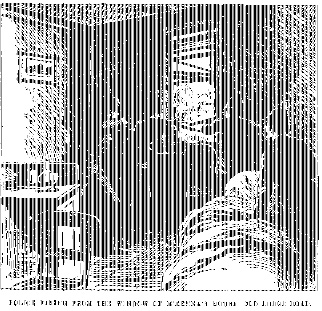
On 6 August, a magistrate’s meeting chaired by Major General Montgomery-Moore, GOC Belfast, recommended a complete withdrawal of the constabulary from the Shankhill. Considering the degree of hostility prevailing towards the police on the Shankhill by that stage, this move made tactical sense. However, the de facto abrogation of police responsibilities to the military was nonetheless a controversial move.
Battle of Springfield
The rioting reached a crescendo on 7 and 8 August. This was a bloody weekend during which nine people died, four of whom succumbed to police rifle fire in one incident outside McKenna’s public house on the Old Lodge Road. Amongst other incidents was a continuous gun battle which raged between Catholics and Protestants for at least five hours. This engagement later entered Belfast folklore as the ‘Battle of Springfield’. After personally surveying the scene at McKenna’s public house, Reed, concerned ‘that we [the RIC] were losing our moral influence with the people on account of being obliged to fire…thought the firing should now stop’. Accordingly he issued orders to ‘avoid firing if possible…[and] to use the truncheon and make as many arrests as they could’. He also decreed that the fifty-fifty mix of riflemen and batonmen in each section should be restored and that no section should be less than twenty in number. Additionally he stipulated that police parties defending houses should not use their firearms to protect those houses, merely themselves in extremis.
As the week progressed the intensity of the rioting decreased and by 13 August the RIC began limited 10 am to 5 pm patrolling of the Shankhill. Despite constant attempts by all sections of the Protestant community to keep the police from the Shankhill and also to remove them from other parts of Belfast, Reed resisted their imprecations and the unarmed policing of the Shankhill was fully resumed on 1 September. On 19 September Catholic rioters tried to seize Divis Street RIC barracks. Nearly succeeding in the attempt, the rioters were beaten off by police rifle fire and three of their number were killed. It was, however, the last serious incident of the 1886 riots and, although rioting continued sporadically until 21 September, the riots were effectively over.
Riots Commission report
On 4 October a government appointed Riots Commission began its deliberations with a broad remit and after interviewing 201 witnesses concluded its proceedings on 25 October. The commissioners laid substantial blame for the origin of the riots on clergymen and politicians who publicly spoke of using violence to resist Home Rule. One of the commissioners, Commander Wallace B. McHardy, Chief Constable of Lanarkshire, disagreed with aspects of his colleagues’ findings and later produced a separate report. McHardy’s criticisms of the RIC in Belfast were trenchant. These involved a wide range of issues from barrack sleeping arrangements to police drill, but he saved his most incisive remarks for their conduct during the riots. In his judgement the arming of the RIC for Belfast duties and the force’s failure to appoint an early inquiry into the Bowershill shooting, were cardinal errors, either of which he maintained, were ‘sufficient to account for the continuance of the disturbances’. One leading Ulster politician, T.W. Russell, remarked that ‘as a police force they [the RIC in Belfast] were a conspicuous failure. They had none of the instincts of policemen, but all the instincts of a military force’.
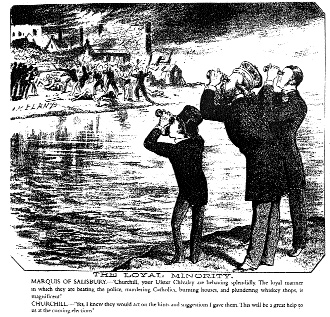
(Weekly News, Dublin, 19 June 1886)
It was a public perception which was played out on the cobblestones of Belfast with the RIC not only failing to contain the crowds with buckshot and ball, but also failing to employ such ‘civil’ tactics as using the baton and arrest technique effectively to ensure a modicum of success. The tactics the police employed in Belfast exacerbated the situation almost from the outset, because they were based on the false premise that these mobs could be controlled virtually by rifle fire alone. The constabulary were not exclusively at fault in this context because their operational movements were often under the personal control of a local magistrate who was frequently inept or indecisive.
There were faults too in the way that the county police reinforcements were deployed: they were inadequately briefed, kept on the streets for too long and poorly housed and fed. In that state they could not have been operating efficiently. Reed’s failure to publicly demonstrate his force’s independence from the government of the day ensured that the wildest rumours regarding the RIC were propagated by and amongst an antipathetic Protestant community, encouraged by an almost universally hostile press. The most damaging rumour that had considerable currency during the riots was that the former Chief Secretary, John Morley, had ‘packed’ Belfast with particularly large numbers of Catholic policemen to enforce Home Rule by the violent suppression of Protestant dissent. But, incredibly, neither the rumour nor the underlying assumption was definitively challenged by the RIC until 7 August. The various rumours and the climate they engendered ensured the continuance of the riots.
The decision to withdraw the constabulary from the Shankhill was a formal admission of the failure of police tactics. That withdrawal gave the rioters the impression that they had mastered the RIC and encouraged ‘respectable citizens’ to think that they could force the RIC out of Belfast and replace them with their own local council controlled force.
Because of the peculiar nature of violent and popular resistance in Belfast to the RIC, it would probably have been impossible to consider riot containment with wholly unarmed policemen. Despite that limitation, there were policing methods which, had they been adopted, might have ameliorated the violence. If, for example, the RIC had reassessed their use of country detachments and pressed for a permanent increase in the local Belfast force, the events of 1886 may not have assumed such a serious aspect.
Conclusion
Frankfort Moore, summing up his account of the 1886 riots concluded: ‘It may, therefore, I think, be said that the spirit of resistance to authority got the better of authority in Belfast at that time’. Publicly the failures of the RIC in Belfast were aired in the commissioners’ inquiry reports, while privately the RIC began to address those failures. The special code of regulations for Belfast, recommended by the Inquiry Commissioners to civilianise and urbanise the Belfast police force, was later produced despite Reed’s initial opposition to it at the inquiry. The rules regarding transfers of policemen from Belfast were further relaxed in another attempt to localise the force and rural reinforcements were never again used in such numbers on the streets of Belfast. As a result of the 1886 riots both the RIC and the government decided thereafter, de facto if not de jure, that the policing of Belfast would be handled differently from the rest of Ireland.
It must be said that the RIC in Belfast during the 1886 riots were, in the words of the commissioners, ‘subjected to almost unparalleled trials’ and there are many cases of individual police gallantry and high standards of discipline within the pages of the commission evidence. However, as a collective body, the RIC to an extent created and lost the trial of strength in 1886. That they did so is due to the inherent contradiction co-existing within the constabulary, who inhibited by the dictates of a paramilitary organisation were unable to resolve the dichotomy between civil and paramilitary policing—a dichotomy that haunts Belfast’s policemen still.
Mark Radford is a postgraduate student at the Institute of Irish Studies, University of Liverpool.
Further reading:
A. Boyd, Holy War in Belfast (Tralee 1969).
I. Budge and C. O’Leary, Belfast: Approach to Crisis. A Study of Belfast Politics 1613-1970 (London 1973).
The author would like to acknowledge with gratitude the assistance of the Leverhulme Trust in the preparation of this article.
















